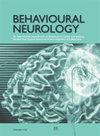Central Auditory Processing Disorder in Patients with Amnestic Mild Cognitive Impairment.
IF 2.7
4区 医学
Q2 CLINICAL NEUROLOGY
Ga-Young Kim, HyangHee Kim, Hee Jin Kim, Sang Won Seo, Duk L Na, Chung Mo Nam, Byoung Seok Ye, Il Joon Moon
下载PDF
{"title":"Central Auditory Processing Disorder in Patients with Amnestic Mild Cognitive Impairment.","authors":"Ga-Young Kim, HyangHee Kim, Hee Jin Kim, Sang Won Seo, Duk L Na, Chung Mo Nam, Byoung Seok Ye, Il Joon Moon","doi":"10.1155/2022/9001662","DOIUrl":null,"url":null,"abstract":"<p><strong>Background: </strong>This study was conducted to comprehensively examine the central auditory processing (CAP) abilities of patients with amnestic mild cognitive impairment (aMCI) as well as to compare the results with cognitively normal elderly controls.</p><p><strong>Methods: </strong>A total of 78 participants were screened through pure-tone audiometry and word recognition score in order to exclude peripheral auditory dysfunction. Forty-five people passed screening tests, and 33 people failed. Finally, 25 aMCI (mean age = 71.52 ± 4.8; male : female = 24 : 76) and 20 controls (mean age = 73.45 ± 4.32; male : female = 45 : 55) were enrolled in the study. Seven CAP tests (frequency pattern test, duration pattern test, Gap-In-Noise<sup>©</sup> test, dichotic digits test, low-pass filtered word test, speech perception in noise test, and binaural fusion test) were conducted only after the two groups passed the screening. A linear mixed model was applied to analyze CAP tests except for the binaural fusion test. For the binaural fusion test, the independent <i>t</i>-test was used to compare the means of test score between two groups.</p><p><strong>Results: </strong>The aMCI group had a decrease in the mean score of the frequency pattern test, duration pattern test, Gaps-In-Noise<sup>©</sup> test, dichotic digits test, and speech perception in noise test compared with the control group.</p><p><strong>Conclusion: </strong>The aMCI group's CAP abilities were significantly lower than those of the control group. Thus, if the cognitive assessment and hearing evaluation are conducted in combination, the sensitivity of the diagnostic process for aMCI will be increased.</p>","PeriodicalId":50733,"journal":{"name":"Behavioural Neurology","volume":"2022 ","pages":"9001662"},"PeriodicalIF":2.7000,"publicationDate":"2022-01-01","publicationTypes":"Journal Article","fieldsOfStudy":null,"isOpenAccess":false,"openAccessPdf":"https://www.ncbi.nlm.nih.gov/pmc/articles/PMC9779989/pdf/","citationCount":"0","resultStr":null,"platform":"Semanticscholar","paperid":null,"PeriodicalName":"Behavioural Neurology","FirstCategoryId":"3","ListUrlMain":"https://doi.org/10.1155/2022/9001662","RegionNum":4,"RegionCategory":"医学","ArticlePicture":[],"TitleCN":null,"AbstractTextCN":null,"PMCID":null,"EPubDate":"","PubModel":"","JCR":"Q2","JCRName":"CLINICAL NEUROLOGY","Score":null,"Total":0}
引用次数: 0
引用
批量引用
Abstract
Background: This study was conducted to comprehensively examine the central auditory processing (CAP) abilities of patients with amnestic mild cognitive impairment (aMCI) as well as to compare the results with cognitively normal elderly controls.
Methods: A total of 78 participants were screened through pure-tone audiometry and word recognition score in order to exclude peripheral auditory dysfunction. Forty-five people passed screening tests, and 33 people failed. Finally, 25 aMCI (mean age = 71.52 ± 4.8; male : female = 24 : 76) and 20 controls (mean age = 73.45 ± 4.32; male : female = 45 : 55) were enrolled in the study. Seven CAP tests (frequency pattern test, duration pattern test, Gap-In-Noise© test, dichotic digits test, low-pass filtered word test, speech perception in noise test, and binaural fusion test) were conducted only after the two groups passed the screening. A linear mixed model was applied to analyze CAP tests except for the binaural fusion test. For the binaural fusion test, the independent t -test was used to compare the means of test score between two groups.
Results: The aMCI group had a decrease in the mean score of the frequency pattern test, duration pattern test, Gaps-In-Noise© test, dichotic digits test, and speech perception in noise test compared with the control group.
Conclusion: The aMCI group's CAP abilities were significantly lower than those of the control group. Thus, if the cognitive assessment and hearing evaluation are conducted in combination, the sensitivity of the diagnostic process for aMCI will be increased.
遗忘性轻度认知障碍患者的中枢性听觉加工障碍。
背景:本研究旨在全面检查遗忘性轻度认知障碍(aMCI)患者的中枢听觉加工(CAP)能力,并将结果与认知正常的老年人对照进行比较。方法:采用纯音测听法和单词识别评分法对78名受试者进行筛选,排除外周听觉障碍。45人通过了筛选测试,33人失败。25例aMCI(平均年龄= 71.52±4.8;男∶女= 24∶76),对照组20例(平均年龄= 73.45±4.32;男性:女性= 45:55)被纳入研究。两组通过筛选后再进行7项CAP测试(频率模式测试、持续时间模式测试、噪声中间隙©测试、二分数字测试、低通滤波单词测试、噪声中语音感知测试、双耳融合测试)。除双耳融合试验外,采用线性混合模型对CAP试验进行分析。双耳融合测试采用独立t检验比较两组测试成绩均数。结果:与对照组相比,aMCI组在频率模式测试、持续模式测试、噪声间隙©测试、二位数测试和噪声语音感知测试中的平均得分均有所降低。结论:aMCI组的CAP能力显著低于对照组。因此,如果认知评估和听力评估相结合,将会提高aMCI诊断过程的敏感性。
本文章由计算机程序翻译,如有差异,请以英文原文为准。

 求助内容:
求助内容: 应助结果提醒方式:
应助结果提醒方式:


